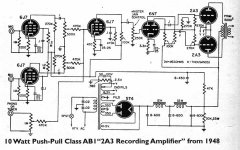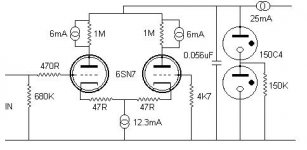Could anyone tell me if I could use a parallel 6N7 to drive a single-ended 2A3 and if so what component values would I need?
I tried this setup with 100k plate resistor and 1k8 cathode R as per rc coupled chart but it didn't work the 100k was dropping too much voltage.I ended up with just 80v across the valve> Any suggestions?
OK,Is this worth trying:
Parallel 6N7G
B+ 290v
Plate resistor 10k
Cathode R 1k Bypassed with 10uF
Cap coupled to 2A3 with 0.22 PIO
470k gridleak resistors
Any suggestions/comments welcome.......
Parallel 6N7G
B+ 290v
Plate resistor 10k
Cathode R 1k Bypassed with 10uF
Cap coupled to 2A3 with 0.22 PIO
470k gridleak resistors
Any suggestions/comments welcome.......
kianbach said:...Plate resistor 10k
...Any suggestions/comments welcome.......
Take a little more for the plate resistor ... 47 kOhm (rp of the 6N7 in parallel is 11 kOhm).
Regards Andreas
AndreasS said:
Take a little more for the plate resistor ... 47 kOhm (rp of the 6N7 in parallel is 11 kOhm).
Regards Andreas
Won't this drop the B+ a bit much though?
What about the cathode resistors are they ok?
As my previous post I used 100k plate R and this dropped too much of the B+ voltage.
hey-Hey!!!,
If the plate load is dropping too much voltage, run less current through it. Increase the cathode resistor, and the plate voltage comes up, yes?
cheers,
Douglas
If the plate load is dropping too much voltage, run less current through it. Increase the cathode resistor, and the plate voltage comes up, yes?
cheers,
Douglas
Well,according to my data book I should be getting -5v on the grid @3mA so I was thinking of running it with an 820 or 1k cathode R BUT with a 47k plate resistor this would drop over 200v from my B+ which is 290v .I was looking at dropping more in the region of 40 to 140V so as to run the valve at 150 - 250 v.My calculations bring a cathode R of 1666 ohms so I suppose a 1k5 would be ok yes?This gives about 3.3 mA.
This would mean a plate R to drop 140v of 42.5k so I suppose a pair of 82k in parallel connected to a 1k5 in series be ok.Any comments? Or am I flogging a dead horse and would be better off using a different valve?
This would mean a plate R to drop 140v of 42.5k so I suppose a pair of 82k in parallel connected to a 1k5 in series be ok.Any comments? Or am I flogging a dead horse and would be better off using a different valve?
To give it a trial I would just keep the component values in the RCA schematic
and use one 6n7 for both channels with single ended 2A3`s
and use one 6n7 for both channels with single ended 2A3`s
IMO 6N7 is not a good driver for 2A3 , in fact finding a driver which can provide 90-100V swing from 300V is going to be difficult unless transformer coupling is used . Anyway , here's my suggestion
6N7
6N7 has only one cathode.
6N7 has only one cathode.
IMO 6N7 is not a good driver for 2A3 , in fact finding a driver which can provide 90-100V swing from 300V is going to be difficult unless transformer coupling is used . Anyway , here's my suggestion using a 6SN7
cheers
316a
Hi!
The 6N7 works nicely as a driver for tubes like 45 or 2A3. However if fed from the same B+ voltage, the available swing with RC coupling will be very limited. RC coupled it would need more like 450V B+. In a 45 or 2A3 amp with common B+ between output stage and driver LC or transformercoupling is needed for the 6N7. Then it works really nice.
Plates and grids need to be tied together. Another nice touch: a 6J5 will drop in without any changes, even with the same socket wiring. This will prvide less gain and a lower impedance drive in the same environment.
Best regards
Thomas
The 6N7 works nicely as a driver for tubes like 45 or 2A3. However if fed from the same B+ voltage, the available swing with RC coupling will be very limited. RC coupled it would need more like 450V B+. In a 45 or 2A3 amp with common B+ between output stage and driver LC or transformercoupling is needed for the 6N7. Then it works really nice.
Plates and grids need to be tied together. Another nice touch: a 6J5 will drop in without any changes, even with the same socket wiring. This will prvide less gain and a lower impedance drive in the same environment.
Best regards
Thomas
How about a SRPP stage... http://ttradio.net/images/srpp.htm
Quote: The maximum non distorted output voltage swing is 134 Vpp from a 300 V B+ supply
Quote: The maximum non distorted output voltage swing is 134 Vpp from a 300 V B+ supply
6n7
Good idea, if you have more than one tube.🙂
How about a SRPP stage... http://ttradio.net/images/srpp.htm
Quote: The maximum non distorted output voltage swing is 134 Vpp from a 300 V B+ supply
Good idea, if you have more than one tube.🙂
- Status
- Not open for further replies.
- Home
- Amplifiers
- Tubes / Valves
- 6n7/2a3

